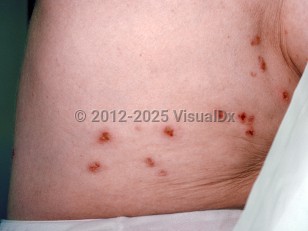Mycoplasma exanthem in Child
Alerts and Notices
Important News & Links
Synopsis

Mycoplasma exanthem is caused by the organism Mycoplasma pneumoniae, one of the most common causes of atypical pneumonia (also called "walking pneumonia") in children and young adults. Mycoplasma are pleomorphic, filamentous bacteria that lack a cell wall, are of a smaller size, and possess different genetic features than other bacteria. Its long incubation period may be responsible for the slowly evolving epidemics seen in young people, military barracks, schools, and families. Rashes frequently occur and can be a diagnostic clue. The incidence of exanthems in association with M pneumoniae has been reported to be between 10% and 35%.
Patients usually have a slowly evolving illness with eventual headache, low-grade fever, malaise, myalgias, dry cough, sore throat, and fatigue. Coughing can be severe and with uncontrolled paroxysms. The disease otherwise tends to be mild and is often self-limited. Symptoms typically last 1-2 weeks followed by gradual resolution of the cough and fatigue.
Skin manifestations typically include erythematous maculopapular and vesicular lesions, distributed on the trunk, arms, and legs. Bullous, petechial, and urticarial lesions have also been reported in the literature. Exanthems are often mild and self-limiting. They may or may not be accompanied by pruritus and can persist for 2 weeks.
Rare complications include hepatitis, meningitis, pericarditis, arthritis, and acute hemolytic anemia. In a few patients, pneumonia can lead to adult respiratory distress syndrome.
Related topics: Mycoplasma pneumonia, reactive infectious mucocutaneous eruption (RIME)
Patients usually have a slowly evolving illness with eventual headache, low-grade fever, malaise, myalgias, dry cough, sore throat, and fatigue. Coughing can be severe and with uncontrolled paroxysms. The disease otherwise tends to be mild and is often self-limited. Symptoms typically last 1-2 weeks followed by gradual resolution of the cough and fatigue.
Skin manifestations typically include erythematous maculopapular and vesicular lesions, distributed on the trunk, arms, and legs. Bullous, petechial, and urticarial lesions have also been reported in the literature. Exanthems are often mild and self-limiting. They may or may not be accompanied by pruritus and can persist for 2 weeks.
Rare complications include hepatitis, meningitis, pericarditis, arthritis, and acute hemolytic anemia. In a few patients, pneumonia can lead to adult respiratory distress syndrome.
Related topics: Mycoplasma pneumonia, reactive infectious mucocutaneous eruption (RIME)
Codes
ICD10CM:
A49.3 – Mycoplasma infection, unspecified site
SNOMEDCT:
406595002 – Infection due to Mycoplasma pneumoniae
A49.3 – Mycoplasma infection, unspecified site
SNOMEDCT:
406595002 – Infection due to Mycoplasma pneumoniae
Look For
Subscription Required
Diagnostic Pearls
Subscription Required
Differential Diagnosis & Pitfalls

To perform a comparison, select diagnoses from the classic differential
Subscription Required
Best Tests
Subscription Required
Management Pearls
Subscription Required
Therapy
Subscription Required
References
Subscription Required
Last Reviewed:07/18/2021
Last Updated:04/01/2025
Last Updated:04/01/2025
Mycoplasma exanthem in Child

